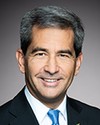This is from our colleague, Mike Bossio, who's an associate member of the committee and represents a riding a bit to the south and west of here. I happened to visit it a little while ago. I talked to the folks in Bancroft at the rod and gun club, which the fish and game association has there.
I think this is consistent with some of the things that Sean Fraser has brought before this committee as well, when he's appeared as an associate member, talking about the whole issue of the ATT.
As you know, Mr. Chair, I think our friend Mark Holland has a little trouble with this right now because of some of the comments he made in the House about the changes to the ATT.
What's at stake here is the fact that Bill C-42 was adopted in the previous Parliament. It provided authorization to transport for the most vetted community in Canada, the firearms community, for anybody who wants to take a restricted firearm in that classification, which is usually, generally, a handgun, pistol, revolver, and some long guns. The only place they are lawfully allowed to take these firearms is to a range or to a competition or to a gun shop. In the previous Parliament, we thought it was onerous that every time they wanted to do something as straightforward as that they would have to get an authorization to transport.
We've heard from various witnesses who've appeared before the committee that the vast majority of times when the electronic ATT, which shows up right away and is easily caught through the information system...whereas a paper one is regressive in the way we do business.
Notwithstanding that, Mr. Bossio is obviously getting some significant pressure, as is Mr. Fraser, who asked these questions as, I imagine, a lot of the rural MPs who are in the governing caucus right now are probably getting. We know that about 2% or 3% of the time at the very most, somebody is transporting a firearm to a gunsmith; that's what's been heard before this committee. It makes no sense to require them to get a paper ATT to do that.
We fully support Mr. Bossio's amendments. Expanding this amendment by re-including the ability to take your restricted firearm to a gunsmith only makes common sense for law-abiding firearms owners. It does nothing to curb crime. I've heard no statistics to suggest that this is what organized crime is doing. They're going through the process of buying a gun licence and getting their RPAL in the guise of taking their firearm to a gunsmith to transport their firearms. Nobody said that in all seriousness.
I would agree with Mr. Bossio, even though I'm sure his colleagues at the table here won't.




